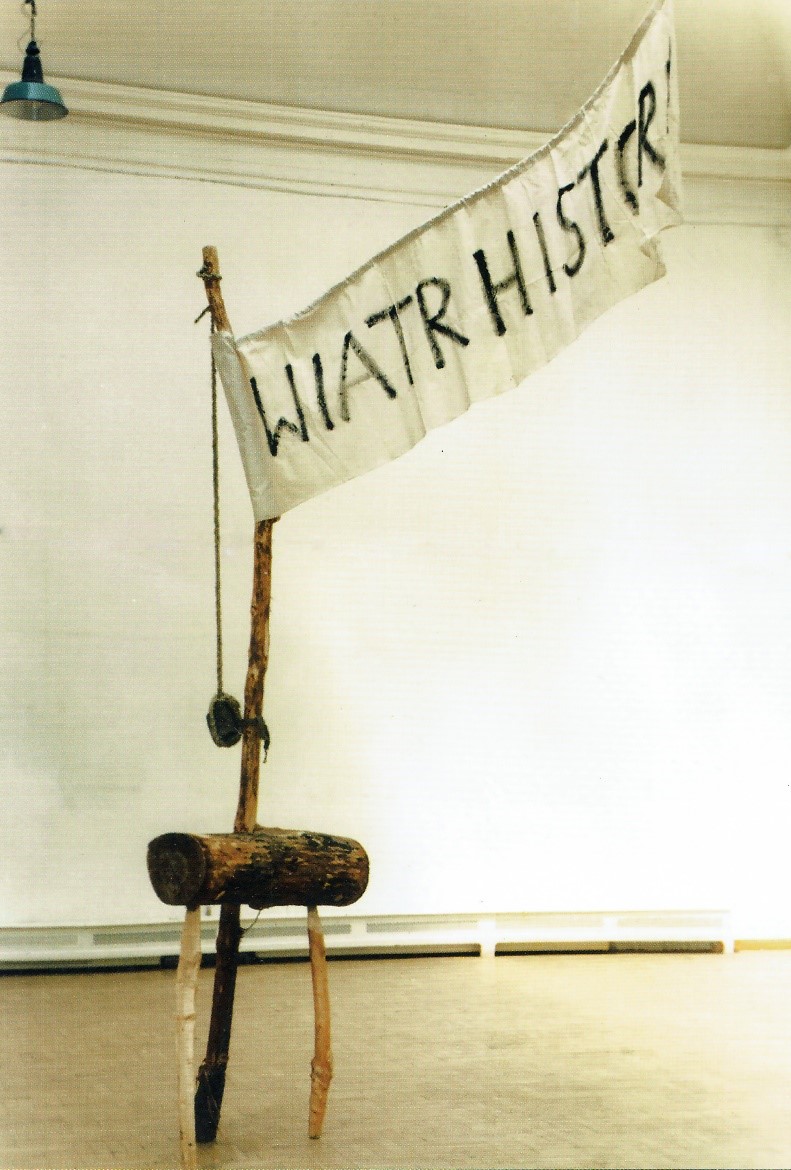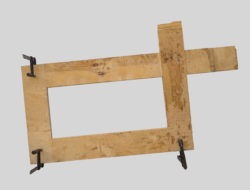Jerzy Bereś, The Altar of Changes (Ołtarz Zmian), 1978
wood, canvas, fabric, brushes (brooms), paint, 350 × 350 × 300 cm (sizes vary)
Jerzy Bereś, The Wind of History (Wiatr Historii), 1995
wood, stone, rope, canvas, paint, 380 × 300 × 180 cm
MYSTICISM
The works of Jerzy Bereś show a clear interest in the values based on symbolism, faith, metaphor and metaphysics. In his art he used artistic manifestations whose form is close to performance and happening, but not directly connected to them. His works can be defined as statements of ethical and political nature. He postulated the superiority of the creative act itself and the process of creating art over the finished product. In his works he used mostly materials of natural origin, such as linen, stone, wood or coal, which further stressed the mysticism of his works. The simplicity of the material, and the apparent coarseness of the form bring to mind the archetypical perception of the basic values of humans, who use their natural environment to create works of art, subordinating the elements but not taking their form away (the wood is only slightly worked). From the prepared elements the artist created structures which stand midway between a sculptural design and a combination of natural elements. The titles of some of his works include references to tradition (a plough, a cart).
MOVEMENT
In 1978, Bereś wrote about his art: „I’m not a sculptor. I stopped being one right after I graduated from the Academy. […] It is hard to divide my work into periods. Let’s try to do so by using the criterion of real movement. In the first half of the 1960s I used the visual effect without the participation of real movement. It was as if a trace of movement and action. […] In the second half of the 1960s, by contrast, I used specific movement. Movement functions as a necessary element of the fact. […] Dilemmas? […] My biggest dilemma is calling my manifestations ‚happenings’. […] I have always insisted on the terms ‘action’, or ‘event’. The difference between a manifestation and a happening is enormous. My manifestations have a programme, an aim, and a capacity to carry meaning. Meanwhile, a happening is ruled by fortuity. […] Unlike a manifestation, a happening lacks aim and capacity to carry meaning. The final formation or deformation of an object begun earlier occurs through action. At the same time, however, the object is used during the course of the action. And what we are dealing with here is the moment of unification. Of the object and the action. We reach completion.” (from: www.culture.pl)
ABOUT THE ARTIST
Jerzy Bereś (1930–2012) studied sculpture at the Kraków Academy of Fine Arts in 1948–50, first under Franciszek Kalfas, and later under Stanisław Popławski and Xawery Dunikowski. Bereś’s works comprised phenomena referred to as art manifestations. They combined happening and performance elements, but the artist himself never classified his work into any of these categories. This allowed him to create his own personal style. In his actions he often used his body, which became an integral part of the artistic work. His works have been frequently awarded prizes and exhibited.
Works purchased for the Collection from the resources of the Ministry of Culture and National Heritage within the Regional contemporary art collections programme of the Centre of Contemporary Art Znaki Czasu in Toruń in 2017.
Tags: blog, collection
 The Institution is funded from the budget of Toruń Municipality
The Institution is funded from the budget of Toruń Municipality














